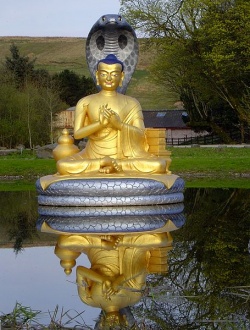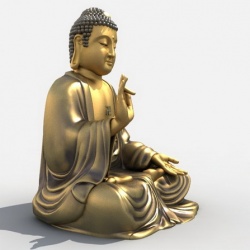The Life of Nagarjuna
In a well-known passage in Gone to Lanka Sutra Buddha is asked who will uphold the doctrine after he has passed away. Buddha replies:
In the Southern region, in the Land of the Palms, The monk Shriman of great renown, Known by the name, 'Naga', Will destroy the positions of existence and non-existence. Having proclaimed to the world my vehicle, The unsurpassed Great Vehicle, He will accomplish the ground, Very Joyful, And depart to the Land of Bliss.
As predicted, four hundred years after Buddha passed away, a son was born to a prosperous Brahmin family living in an area of Southern India known as Bedarwa, or the 'Land of the Palms'. An oracle predicted that the child would live for only seven days, but that his life span could be extended by a further seven days if gifts were bestowed upon a hundred ordinary people, by a further seven months if offerings were made to a hundred brahmins, or by a further seven years if offerings were made to a hundred monks. However, the oracle knew of no method to extend his life beyond that. Accordingly, his parents made offerings to a hundred monks and as a result were able to live happily with their son for seven years.
As the child's eighth birthday drew near, however, they sent him on a pilgrimage with several of their servants, for they could not bear to witness his death. Guided by a manifestation of Avalokiteshvara, the party made its way to Nalanda Monastary where they met the great Teacher Saraha. They explained the boy's plight to Saraha, and he told them that the child could avert an untimely death by staying at Nalanda and ordaining as a monk. He gave the child an empowerment into the long-life practice of Buddha Amitayus, and encouraged him to practice that yoga extensively. On the eve of his eighth birthday the child recited the mantra of Amitayus without interruption and, as a result, averted untimely death. The following day he ordained as a monk and was given the name Shrimanta. He remained at Nalanda where, under the protection of Manjushri, he was able to study all the Sutras and Tantras. He soon became a fully-accomplished scholar and Teacher, and his reputation spread widely. Eventually he was appointed Abbot of Nalanda.
Nagarjuna's life comprised three great periods of auspicious deeds that correspond to Buddha's three turnings of the Wheel of Dharma; which is why he is often referred to as 'the Second Buddha'. The first period was during his tenure as Abbot of Nalanda. Unfortunately, the moral discipline of the monks had degenerated since the time of Buddha first gave vows, and Nagarjuna was very active in restoring the purity of the discipline. He clarified many points of moral discipline in extensive teachings, and composed a number of works on pure conduct. These writings, known as the Collection of Advice, include such works as Precious Garland, Friendly Letter, Tree of Wisdom, A Hundred Wisdoms, and Drops for Healing Beings. These activities are likened to Buddha'a first turning of the Wheel of Dharma.
Nagarjuna is best remembered, however, for the works of the second period. Not long after Buddha passed away, the Perfection of Wisdom Sutras, the principle Mahayana teachings, disappeard from this world. It is said that this is because some nagas who had received this teaching from Buddha had taken the Perfection of Wisdom Sutras to their own world for safekeeping. There remained only a few practitioners who could understand these teachings, and most of them kept their practice secret. The only teachings of Buddha to remain widespread were the Hinayana teachings; and as a result many people assumed that these were the only teachings Buddha had given. Some time later the nagas invited Nagarjuna to visit them, and returned the Perfection of Wisdom scriptures to him. Nagarjuna brought the scriptures to the human world and propagated them widely. Because of his special relationship with the nagas, and because he cured many nagas of sickness by means of special ritual prayers, Nagarjuna was given the name 'Protector of the nagas'. 'Arjuna' was added to his name because he spread the Mahayana teachings with great speed and accuracy, just as the legendary archer, Arjuna, had delivered arrows from his bow. Hence he finally became know as 'Protector Nagarjuna'.
Because he had a very lucid mind and great wisdom, Nagarjuna was able perfectly to understand the Perfection of Wisdom Sutras and explain them to others. He spread these teachings widely, thus instigating a great revival of the Mahayana doctrine in this world. He presented a system of reasoning which, because it steers a flawless course between the two extremes of existence and non-existence, became known as the 'philosophy of the middle way', or 'Madhyamaka'. Nagarjuna composed many commentaries to the Perfection of Wisdom Sutras that elucidate the Madhyamaka view. These treatises, known as the Collection of Reasonings, include the famous Fundamental Wisdom of the Middle Way, and its four limbs: Sixty Reasonings, Seventy Emptinesses, Finely Woven, and Refutation of Objections. He also wrote Compendium of Sutras, Five Stages of the Completion Stage of Guhyasamaja, and many other commmentaries to the Sutras and Tantras. These activities are likened to Buddha's second turning of the Wheel of Dharma.
Nagarjuna's third period of auspicious deeds took place towards the end of his life. Acting on advice from Tara, he returned to Southern India and dwelt at a place called Mount Splendour, where he gave further extensive teachings on both the Sutras and Tantras, and composed many more texts. These writings, known as the Collection of Praises, include such works as Praise to the Dharmadhatu, Praise of the Supramundane, Praise of the Inconceivable, and Praise of the Ultimate. These activities are likened to Buddha's third turning of the Wheel of Dharma.
It is not possible in such a brief account even to begin to do justice to Nagarjuna's life and works. Throughout his life he devoted himself entirely to reviving the Mahayana Dharma and to sustaining the Mahayana Sangha. To this end he gave prolific teachings, composed many books, and performed countless other virtuous deeds. In all, Nagarjuna lived for over six hundred years.
From the book Ocean of Nectar by Geshe Kelsang Gyatso

